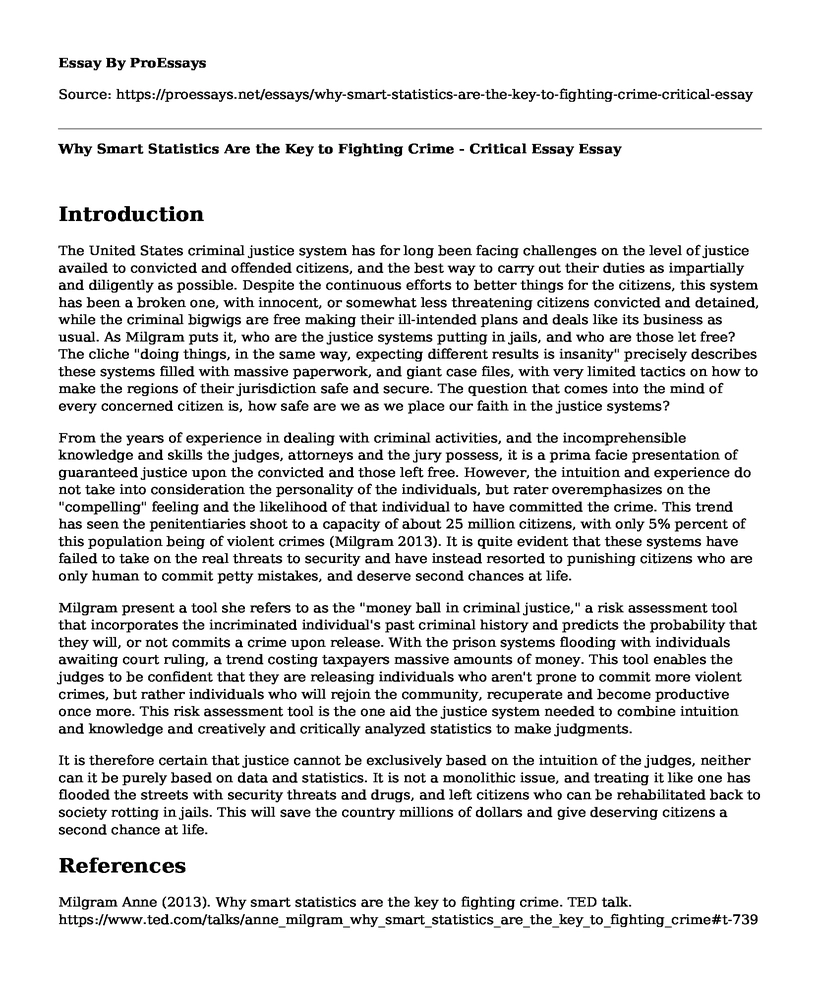Introduction
The United States criminal justice system has for long been facing challenges on the level of justice availed to convicted and offended citizens, and the best way to carry out their duties as impartially and diligently as possible. Despite the continuous efforts to better things for the citizens, this system has been a broken one, with innocent, or somewhat less threatening citizens convicted and detained, while the criminal bigwigs are free making their ill-intended plans and deals like its business as usual. As Milgram puts it, who are the justice systems putting in jails, and who are those let free? The cliche "doing things, in the same way, expecting different results is insanity" precisely describes these systems filled with massive paperwork, and giant case files, with very limited tactics on how to make the regions of their jurisdiction safe and secure. The question that comes into the mind of every concerned citizen is, how safe are we as we place our faith in the justice systems?
From the years of experience in dealing with criminal activities, and the incomprehensible knowledge and skills the judges, attorneys and the jury possess, it is a prima facie presentation of guaranteed justice upon the convicted and those left free. However, the intuition and experience do not take into consideration the personality of the individuals, but rater overemphasizes on the "compelling" feeling and the likelihood of that individual to have committed the crime. This trend has seen the penitentiaries shoot to a capacity of about 25 million citizens, with only 5% percent of this population being of violent crimes (Milgram 2013). It is quite evident that these systems have failed to take on the real threats to security and have instead resorted to punishing citizens who are only human to commit petty mistakes, and deserve second chances at life.
Milgram present a tool she refers to as the "money ball in criminal justice," a risk assessment tool that incorporates the incriminated individual's past criminal history and predicts the probability that they will, or not commits a crime upon release. With the prison systems flooding with individuals awaiting court ruling, a trend costing taxpayers massive amounts of money. This tool enables the judges to be confident that they are releasing individuals who aren't prone to commit more violent crimes, but rather individuals who will rejoin the community, recuperate and become productive once more. This risk assessment tool is the one aid the justice system needed to combine intuition and knowledge and creatively and critically analyzed statistics to make judgments.
It is therefore certain that justice cannot be exclusively based on the intuition of the judges, neither can it be purely based on data and statistics. It is not a monolithic issue, and treating it like one has flooded the streets with security threats and drugs, and left citizens who can be rehabilitated back to society rotting in jails. This will save the country millions of dollars and give deserving citizens a second chance at life.
References
Milgram Anne (2013). Why smart statistics are the key to fighting crime. TED talk. https://www.ted.com/talks/anne_milgram_why_smart_statistics_are_the_key_to_fighting_crime#t-739719
Cite this page
Why Smart Statistics Are the Key to Fighting Crime - Critical Essay. (2022, Jul 25). Retrieved from https://proessays.net/essays/why-smart-statistics-are-the-key-to-fighting-crime-critical-essay
If you are the original author of this essay and no longer wish to have it published on the ProEssays website, please click below to request its removal:
- Essay Example on White-Collar Crime and Deviance
- Illegal Immigrants Should Have the Same Rights as Everyone in America - Essay Sample
- The Legalisation of Marijuana Essay Example
- Correction Officers Career Analysis Paper Example
- Inclusion of College Football as Part of the Areas Covered by Title IX of the Education Amendments Act
- Essay Example on Justice System: Challenges & Agencies' Functions
- The Vitality of Personal Data Privacy: Trust & Security - Free Paper Example







